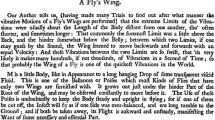Summary
Ionic mechanisms of the action potential of longitudinal flight muscle fiber were studied in the fly,Sarcophaga bullata. Depolarization of the fiber membrane initiates the fast spikes which may be followed by a plateau response. The fast spike is a graded response in normal saline, but is converted to an all-or-none response in TEA solutions. It is eliminated in Ca-free media, suppressed by 12 mM Co++, and the overshoot increases with an increasing Ca++ concentration. Both the spikes and the plateau are TTX insensitive. Although the fast spike is produced in Na-free media, the rate of rise and overshoot of the spike are reduced. However, Na+ will not support spikes in the absence of Ca++. Plateau responses in normal saline are about 12 s in duration with a potential level of about −25 mV. Both the plateau potential and duration increase with an increasing Na+concentration, and the plateaus are eliminated in Na-free media.
Similar content being viewed by others
References
Cerf, J.A., Grundfest, J.H., Hoyle, G., McCann, F.V.: The mechanism of dual responsiveness in muscle fibres of the grasshopperRomalea microptera. J. gen. Physiol.43, 377–395 (1959)
Ephrussi, B., Beadle, G.W.: A technique of transplantation forDrosophila. Amer. Nat.70, 218–225 (1936)
Fatt, P., Ginsborg, B.L.: The ionic requirements for the production of action potentials in crustacean muscle fibres. J. Physiol. (Lond.)142, 516–543 (1958)
Hagiwara, S.: Calcium spike. In: Advances in biophysics, Vol.4 (ed. M. Kotani), pp. 71–102. Tokyo: University of Tokyo Press 1973
Hagiwara, S., Naka, K.J.: The initiation of spike potential in barnacle muscle fibres under low intracellular calcium. J. gen. Physiol.48, 141–162 (1964)
Hagiwara, S., Osawa, S., Sand, O.: Voltage clamp analysis of two inward current mechanisms in the egg cell membrane of a starfish. J. gen. Physiol.65, 617–643 (1975)
Hodgkin, A.L., Huxley, A.F.: Currents carried by sodium and potassium ions through the membrane of the giant axon ofLoligo. J. Physiol. (Lond.)116, 449–472 (1952)
Hogg, J., Williams, E.J., Johnston, R.J.: The membrane electrical parameters ofNitella Translucens. J. theoret. Biol.24, 317–334 (1969)
Huddart, H.: The effect of sodium ions on resting and action potentials in skeletal muscle fibre ofBombyx Mori (L). Arch. int. Physiol. Biochim.74, 592–602 (1966)
Ikeda, K., Kaplan, W.D.: Neurophysiologieal genetics inDrosophila melanogaster. Amer. Zool.14, 1055–1066 (1974)
McCann, F.V.: Unique properties of the moth myocardium. Ann. N.Y. Acad. Sci.127, 84–99 (1965)
Pringle, J.W.S.: Locomotion: Flight. In: The Physiology of insecta, Vol. 3 (ed. M. Rockstein), pp. 433–476. New York and London: Academic Press 1974
Reuter, H.: Divalent cations as charge carriers in excitable membranes. In: Progress in biophysics and molecular biology Vol. 26 (ed. J.A.V. Butler, D. Noble), pp. 1–43. Oxford and New York: Pergamon Press 1973
Rheuben, M.S.: The resting potential of moth muscle fibre. J. Physiol. (Lond.)225, 529–554 (1972)
Smith, D.S.: The organization and function of the sarcoplasmic reticulum and T-system of muscle cells. Progr. Biophys. molec. Biol.16, 107–142 (1966)
Usherwood, P.N.R.: Electrochemistry of insect muscle. In: Advances in insect physiology, Vol. 6 (eds. J.W.L. Beament, J.E., Treherne, V.B. Wigglesworth), pp. 205–278. London and New York: Academic Press 1969
Washio, H.: The ionic requirements for the action potentials in insect muscle fibers. J. gen. Physiol.59, 121–134 (1972)
Werman, R., McCann, F.V., Grundfest, H.: Graded and all-or-none electrogenesis in arthropod muscle. I. The effects of alkali-earth cations on the neuromuscular system ofRomalea microptera. J. gen. Physiol.44, 979–995 (1961)
Wood, D.W.: The effect of ions upon neuromuscular transmission in a herbivorous insect. J. Physiol. (Lond.)138, 119–139 (1957)
Author information
Authors and Affiliations
Additional information
I wish to express my indebtedness to Dr.'s S. Hagiwara, S. Ozawa, and K. Ikeda for their valuable advice during the course of these experiments and in the preparation of this manuscript. I would also like to thank Dr. S. Krasne and L. Jaffe for their critical reading of this manuscript. This work was supported by the United States Public Health Service grants, NS 09012 to Dr. Hagiwara, and Training Grant GM 448.
Rights and permissions
About this article
Cite this article
Patlak, J.B. The ionic basis for the action potential in the flight muscle of the fly,Sarcophaga bullata . J. Comp. Physiol. 107, 1–11 (1976). https://doi.org/10.1007/BF00663915
Received:
Issue Date:
DOI: https://doi.org/10.1007/BF00663915



